NREL Water Power Newsletter, The Current, Winter 2024
In this issue, learn about NREL’s Fiscal Year 2023 water power accomplishments, explore careers in water power, catch up on hydropower and marine energy news, and more.
This quarterly newsletter highlights the latest from NREL's Water Power Program.
Subscribe to Newsletter
To receive quarterly updates about NREL water power news, accomplishments, events, and more, subscribe to The Current newsletter.
SUBSCRIBEIn This Issue
2023 in Review
NREL's Fiscal Year 2023 Water Power Achievements
Join us in celebrating NREL’s water power research wins in this Fiscal Year 2023 NREL water power accomplishments report. See how NREL researchers are helping to advance marine energy technologies and support the changing role of hydropower in the grid.
2023 Top News Stories and Downloaded Publications
News Stories
A lot happened this past year. To recap, we rounded up our top stories from 2023 in one can’t-miss list:
- A Hero’s Journey: NREL’s Wave-Powered Desalination Device Returns to the Outer Banks
- NREL at Clean Currents
- New Tool Helps Researchers Make the Most of Wave Power
- Take a Trip to Renewable Energy Discovery Island: Tour a Virtual Island Run on Water Power
- Video: Dive Into the Marine Energy Atlas
- No Ocean Needed To Validate Offshore Tech With New Motion Platform
- New Tool Provides Accurate Building Cost Estimates for Pumped Storage Hydropower Facilities
- New Study Provides Better Estimates of How Much Power Is Contained in Ocean Waves
- Video: NREL on the Coast
- How Deep Is Your Ocean Love? Get to Know Will Wiley, Arielle Cardinal, and Levi Kilcher
Publications
NREL’s water power researchers had another busy year of publishing groundbreaking and impactful research. The directorate’s publications logged more than 10,600 downloads this past fiscal year. See our list of the top 10 downloaded publications from Fiscal Year 2023:
- U.S. Hydropower Workforce: Challenges and Opportunities
- Review of Wave Energy Converter Power Take-Off Systems, Testing Practices, and Evaluation Metrics: Preprint
- Mission Analysis for Marine Renewable Energy to Provide Power for Marine Carbon Dioxide Removal
- Hydropower Cybersecurity Value-at-Risk Framework
- PacWave Anchoring and Mooring Study
- Subcomponent Validation of Composite Joints for the Marine Energy Advanced Materials Project
- The Role of Hydropower Flexibility in Integrating Renewables in a Low-Carbon Grid
- Distributed Embedded Energy Converter Technologies for Marine Renewable Energy: A Technical Report
- Next-Generation Marine Energy Software Needs Assessment
- Review of WEC-Sim Development and Applications
Curious About a Career in Water Power?
New Hydropower and Marine Energy Career Maps Outline Pathways to Clean Energy Jobs
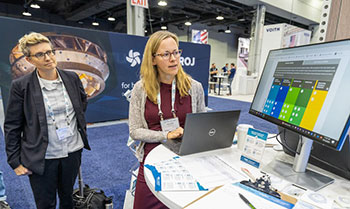
Pursue a Career in Water Power at NREL
R11916—Water Power Technology Validation Group Manager
R11579 Postdoctoral Researcher—Marine Energy Numerical Model and Analysis Engineer
R11550 Research Technician—Electronics, Wind and Water Power Technology
Check out the NREL Careers page to explore a future with NREL.
Hydropower News
Hydropower Is Global; Shouldn’t Hydropower Research Be, Too?
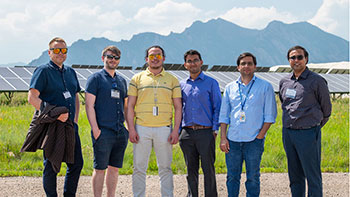
NREL Water Power Research Flourishes Under Seedlings Program
WPTO’s Seedling and Sapling program provides funding to national laboratory researchers, empowering them to think outside the box when it comes to their water power research—and to fine-tune their ideas so they have real-world applications.
Through the program, researchers propose a small hydropower or marine energy project—one that can be accomplished within a year and under $100,000—that they feel uniquely qualified to tackle. A team of experts at WPTO then gives the go-ahead to projects that they think will move the needle on water power research and help the country achieve its decarbonization goals. Learn more about the projects funded under this program.
New Research Solidifies Hydropower’s Key Role in Renewable Energy Grid
NREL researchers published two white papers analyzing hydropower and pumped storage hydropower’s role in a future clean energy grid. The two studies demonstrate that hydropower could support and accelerate the country’s transition to clean energy by helping to reduce energy costs and providing critical energy storage. Explore the first report and the second report.
Marine Energy News
Ocean Energy Could Be a Golden Thread for Coastal Communities
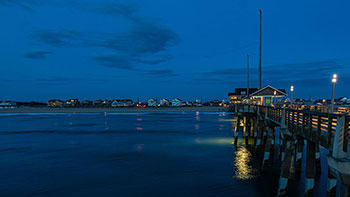
Waves, tides, and currents hold an immense amount of energy that could sustain remote coastal and island communities in an entirely new way. But what if a framework existed that could guide renewable energy experts as they support communities in their clean energy transition, empowering communities to determine where and how marine energy fits within their home based on their unique relationships to the ocean and environment?
To help answer that question, researchers at NREL and Pacific Northwest National Laboratory are developing the Deployment Readiness Framework to support energy transitions in remote coastal and island communities. Researchers, technical assistance experts, and program officers at DOE can use this framework to better understand where communities are in their energy transition and how to meet community needs with technical assistance or financial support.
Module Enhancements Implemented for Marine and Hydrokinetic Toolkit Version 7
A new version of the Marine and Hydrokinetic Toolkit (MHKiT) has just been released, featuring enhancements to two key modules that allow users to calculate lay length of mooring lines, visualize mooring line movements in 2D and 3D, and incorporate turbulence into their modeling. In addition, Version 7 enables users to fetch data from the National Data Buoy Center directly through MHKiT. The open-source toolkit equips developers with the code needed to assess the performance of marine energy technologies in ocean and river sites.
Mooring Study Helps Prepare for Wave Energy Device Validation at PacWave
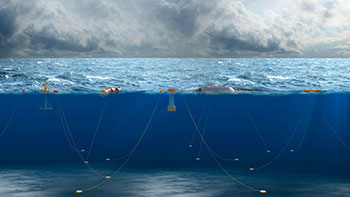
Wave Energy Converter SIMulator Now Connected to Offshore Wind Turbine Modeling Tool
Wave Energy Converter SIMulator (WEC-Sim), an open-source modeling tool developed by NREL and Sandia National Laboratories, can now be used alongside MATLAB for Offshore Wind Turbine Simulation Tool (MOST), a software that simulates floating offshore wind turbines, hybrid wind-wave energy converters, platforms with multiple turbines, and more. Integrating models from two different technology areas—water and offshore wind—WEC-Sim and MOST are now packaged, installed, and run together to ensure ease of use by designers and developers looking to model hybrid energy systems.
A New Way To Test Wave Energy Devices—and Some Messy Data—Could Help Emerging Technologies Succeed in the Ocean
A new NREL testing platform can help marine energy developers collect more accurate data on how well their devices might perform on the open ocean—all without the time, cost, and risk associated with going into the water. The team’s new testing platform pairs theoretical models, which imitate real ocean waves, with a physical generator or other device component. With this more comprehensive and accurate platform, developers can be far more confident that their device and its components will work as expected out at sea.
Newly Patented Electrostatic Generator Could Produce Renewable Energy From Ocean Waves (and More)
An ultra-flexible, centimeter-sized electric generator recently earned its first patent. Called hexagonal distributed embedded energy converters (or hexDEECs), these malleable energy generators are built with resilient and affordable materials, like silicone rubber, which makes them a cost-effective option for a powerful, salty ocean. Although the hexDEEC inventors from NREL are focusing on weaving their devices into larger wave energy converters, these so-called metamaterials could potentially be used to create flexible nets, rope, clothing, walls, or even roads that generate energy or shapeshift to perform other functions. For example, solar panels built from hexDEECs could, in theory, shake off dust, enabling them to generate more energy.
NREL and Student Researchers Advance Marine Energy Tech With Origami, Acrylic Skins, and Flexible Flaps
NREL has teamed up with student researchers to develop distributed embedded energy converter technologies—or DEEC-Tec—a new type of marine energy technology that could enable wave energy technology developers to interweave small individual generators into devices of almost any shape or size. Such materials could bend, twist, or even stretch in ocean waves to harness that rambunctious energy in an entirely new way. This innovative work, which won two WPTO Seedling awards in 2020, can help develop marine energy devices that can power coastal communities, marine research, and even a future clean energy grid.
Testing the Waters With NREL's Wave Tank and Rapid Prototyping Process
NREL’s water power team is developing high-quality, lab-based validation methods to validate and improve outcomes of marine energy technologies before they go into open waters. Researchers leverage NREL’s world-class facilities and equipment to take marine energy devices from design concepts to wave tank prototyping all in one place, allowing for systems to be optimized and de-risked before open-ocean testing. Check out the process up close.
Prizes and Competitions
Accelerating Power at Sea for a Thriving Blue Economy
The U.S. Department of Energy recently launched the Powering the Blue Economy™: Power at Sea Prize, in which teams will compete to advance offshore technologies that can harness some of the ocean’s immense energy (also known as marine energy, or energy generated from waves, currents, tides, or even changes in salinity, pressure, or temperature). Through two prize phases, teams will explore how to build technologies that could support offshore activities—such as marine research or seafood farming—while protecting the ocean’s vast resources (a concept known as Powering the Blue Economy).
H2Os Prize Winner Named; InDEEP Prize Announces Phase 1 Awardees
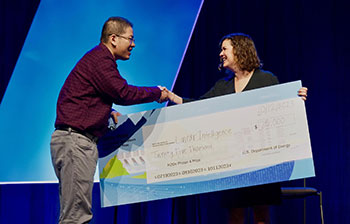
The winners of the fourth and final phase of the Hydropower Operations Optimization Prize were announced at an event held during this year’s Clean Currents conference. The first-place winner, Linear Intelligence of Apex, North Carolina, took home $25,000 while three other teams split the remaining $45,000 prize pool. The H2Os Prize is funded by WPTO.
Phase I winners of the Innovating Distributed Embedded Energy Prize (InDEEP) have been announced. Nineteen teams received $15,000 each for their novel distributed embedded energy converter technology concepts, which will lay the foundation to harness and convert the power of ocean waves into usable energy. Phase II, which is open to new and returning teams, will close in April 2024.
Community Energy Innovation Prize Announces Collegiate Track Concept Winners
Five teams were named CONCEPT Phase winners in the Collegiate Track of the Community Energy Innovation Prize. The winners were selected for their ideas on how to get clean energy benefits to local underserved communities. The team’s associated academic institutions were awarded $15,000 each, and students will also receive in-kind mentorship in the PROGRESS phase. The Clean Energy Ecosystem and Manufacturing Ecosystem Tracks are still in the CONCEPT Phase, but Collegiate Track winners will be moving into the second of three prize phases, the PROGRESS Phase, to begin bringing their ideas to life.
Beneath the Surface: Nicole Mendoza Is a Supersonic Environmentalist
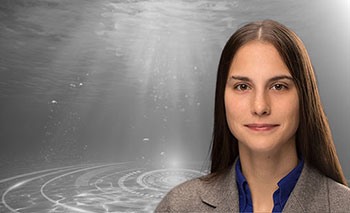
Nicole Mendoza helps perfect technologies that can protect the “wonderful, beautiful blue marble that we all share,” as she puts it. She’s working to build more efficient offshore wind turbines, improve water equity with help from hydropower, and redefine what makes technology ready for commercial use (adding, for example, social and environmental impacts). She’s also designing a kelp-like wave energy device that could generate energy from the ocean while protecting it. Her kelp forest could even act as an artificial reef, attracting phytoplankton, which bring shrimp and finally fish.
“My vision is that this technology helps build the ecosystem from the ground up,” Mendoza said, “being beneficial to the environment, not just neutral.”
In our profile, Nicole Mendoza shared why she left medicine for scramjets, how she’s helping diversify science, technology, engineering, and mathematics (STEM), and what makes her “scrappy.”
Events and Opportunities
Visit the NREL Water Research Events page for more event information and registration details on upcoming workshops.
Past Event
American Geophysical Union Fall Meeting Recap
Dec. 11–15, 2023, San Francisco, California
WPTO had a booth at the American Geophysical Union Fall Meeting in San Francisco this past December. Stuart Cohen of NREL spoke in two sessions: The first was a DOE-led town hall titled "The Rapidly Changing Landscape of Energy-Water Connections: Opportunities Spanning Science to Applications at the U.S. Department of Energy," where he joined other national lab and DOE representatives to talk about ongoing projects and opportunities that bridge basic research funded by DOE’s Office of Science and applied research funded by WPTO. He gave an overview of the crosscutting project "Water Risk for the Bulk Power System: Asset to Grid Impacts," which is also supported by DOE’s Office of Fossil Energy and Carbon Management and Office of Nuclear Energy. Later in the conference he gave a research presentation called "Water Risks to Power Sector Planning Under Alternative Climate and Electricity Futures" that described the grid planning component of the Water Risk project.
Ali Chamas, also of NREL, presented on the WaterPACT project, which focuses on assessing microplastic concentrations in U.S. rivers to develop sensing and collection technologies for future remediation.
Both Cohen and Chamas commented that they met with scientists, professionals, and others who work in the same field and are facing similar changes with certain analytical methods.
Upcoming Events
Pan-American Marine Energy Conference
Jan. 22–24, 2024, Barranquilla, Colombia
The Pan-American Marine Energy Conference brings together researchers, governments, and industry with an interest in marine renewable energy in the Americas (including the Caribbean) through a biannual conference. Workshops are being offered in advance of the conference, including an Introduction to WEC-Sim and its advanced features developed by NREL and Sandia National Laboratories.
Energy Transition Summit: Modernization Initiative and Clean Energy Cybersecurity
Feb. 5–8, 2024, Arlington, Virginia
Panelists from industry and DOE will present strategies for modernizing the grid while advancing national goals in energy resilience, security, and affordability. The event includes strategy talks, training exercises, and cross-sector conversation with research institutions, government officials, communities, and thought leaders in tech and energy.
Northwest Hydroelectric Association's Annual Conference
Feb. 6–8, 2024, Seattle, Washington
NREL Hydropower Subprogram Manager Jennifer Daw will be hosting a Hydropower Workforce Panel on Feb. 7 during Northwest Hydroelectric Association's annual conference to discuss perspectives and best practices on how the hydropower industry is addressing knowledge transfer, succession planning, and diversity, equity, and inclusion in the workforce.
Marine Energy Career Panel
Feb. 7, 2024, 3 p.m. PT, Online via Zoom
Are you interested in working to help build a clean energy future? Pacific Northwest National Laboratory, NREL, and Sandia National Laboratories invite you to join an informational Marine Energy Career Panel featuring DOE national laboratory staff working to advance the marine energy industry.
Staff across various research disciplines will discuss their marine energy careers (past, present, and future), including their background, education, career path, and current projects. In addition, topics including mentorship, networking, and interpersonal communication skills will be addressed to extend advice to students who are preparing to graduate and enter into internship experiences or the marine energy workforce. The Marine Energy Career Panel will start with a brief introduction from the national laboratories, followed by introductions from each of the panelists and a moderated Q&A session.
Ocean Sciences Meeting
Feb. 18–23, 2024, New Orleans, Louisiana
The Ocean Sciences Meeting is the flagship conference for the ocean sciences and the larger ocean-connected community. Several NREL researchers and staff will be in attendance. On Feb. 19, NREL researcher Jon Weers will be hosting the workshop “Interactive Site Selection for Marine Energy Projects Using the Marine Energy Atlas.”
CEATI International’s Hydropower Conference
March 19–20, 2024, Palm Springs, California
On the second day of CEATI, NREL Hydropower Technical Lead Greg Stark will host a session called “Coordination of the Mid-Columbia Hydropower Projects.” Join to learn more about NREL's work in developing and applying a coordinated modeling framework that quantifies the value of coordination, identifies where value accrues, and investigates how to improve market operation software.
NREL in the News
CPR News interviewed Scott Jenne for a story on the wave tank called "Why the Future of Wave Energy Runs Through Colorado."
ScienceX reposted the NREL article on REDi Island’s hydropower technologies.
Hydro Review published a story on the new Deployment Readiness Framework.
9News interviewed Scott Jenne about NREL’s large-amplitude motion platform and Charles Candon about NREL’s wave tank.
TechXplore reposted our article on the PacWave mooring systems study; Offshore Energy wrote their own story.
CleanTechnica covered the PacWave mooring study and picked up the Beneath the Surface article on NREL’s testing team.
Tech Briefs TV reposted our video on the wave tank with a short highlight on NREL water power.
TechXplore picked up the NREL story on the Verdant Power follow-up work and NREL’s resource characterization methodology.
An opinion piece in California's The Mercury News promoted wave energy and cited NREL studies.
Marine Technology News and Offshore Energy both promoted the new Powering the Blue Economy: Power at Sea Prize.
Publications
See all the latest publications, or explore these featured publications.
Hydropower and Marine Energy
A Component-Level Bottom-Up Cost Model for Pumped Storage Hydropower, NREL Technical Report (2023)
How Today’s Hydropower Impacts Tomorrow’s Grid: Counterfactual Scenarios Showing What Happens if Hydropower Goes Away, NREL Technical Report (2023)
Mission Analysis for Marine Renewable Energy to Provide Power for Marine Carbon Dioxide Removal, NREL Technical Report (2023)
Public Value Mapping to Assess and Guide Governmental Investments in Energy and Environmental Justice: Studying the United States Department of Energy, Renewable and Sustainable Energy Reviews (2023)
Numerical Methods to Evaluate Hyperelastic Transducers: Hexagonal Distributed Embedded Energy Converters, Energies (2023)
Report on the 4th Marine Energy Instrumentation and Data Workshop, NREL Technical Report (2023)
Static and Fatigue Characterization of Large Composite T-Bolt Connections in Marine Hygrothermal Environments, Journal of Marine Science and Engineering (2023)
Tidal Resource Gaps Analysis Technical Report, NREL Technical Report (2023)
Want More?
Subscribe to The Current to get the next water power newsletter in your inbox.
For the latest from the DOE Water Power Technologies Office, sign up for its water power newsletters. Have a more general question or can’t find what you’re looking for? Send us an email at water.power@nrel.gov.
Share
